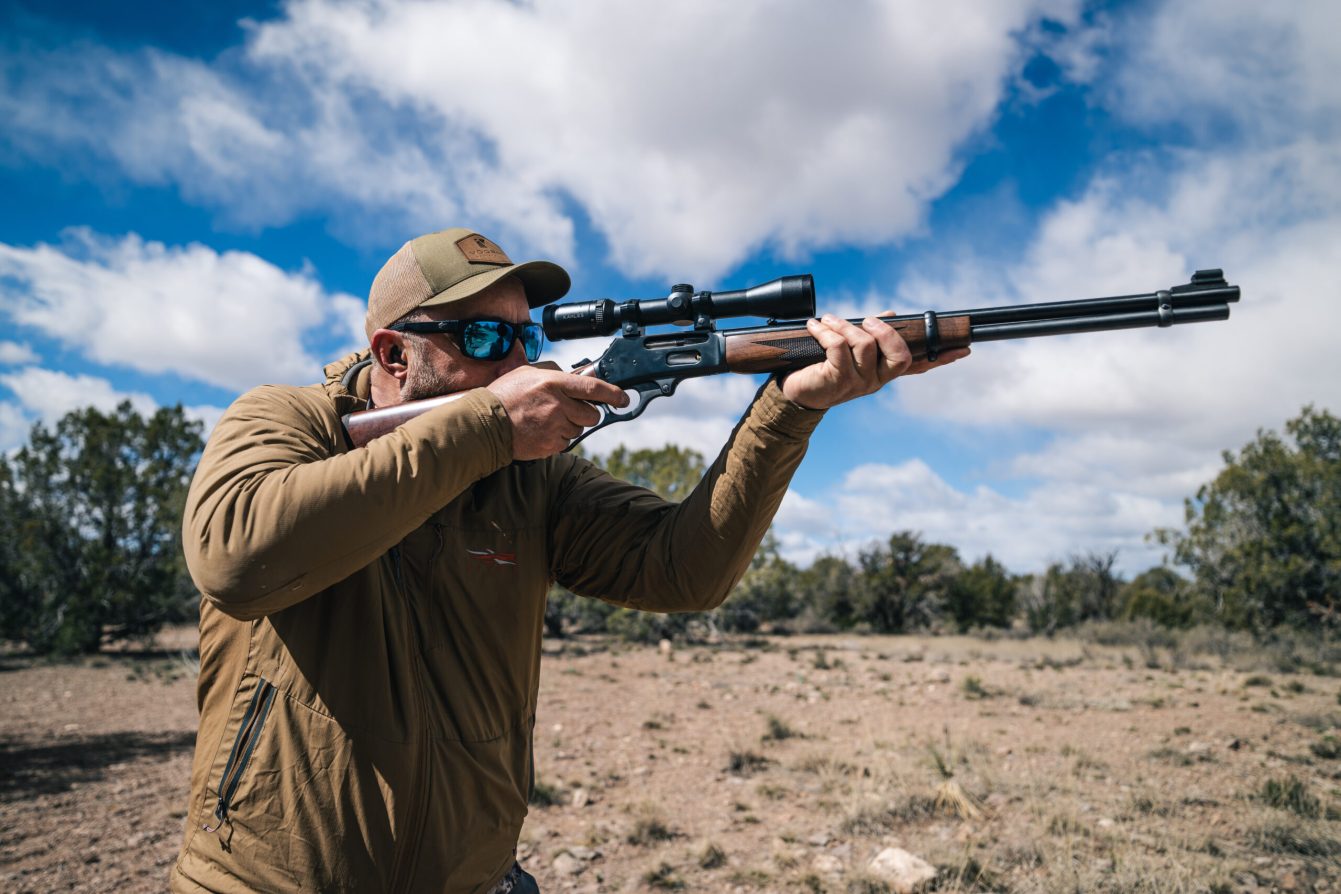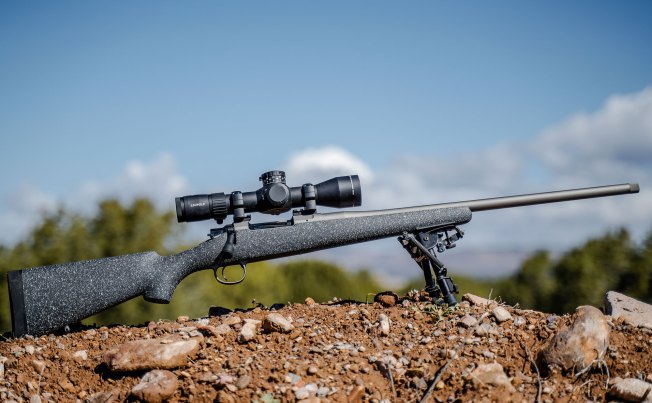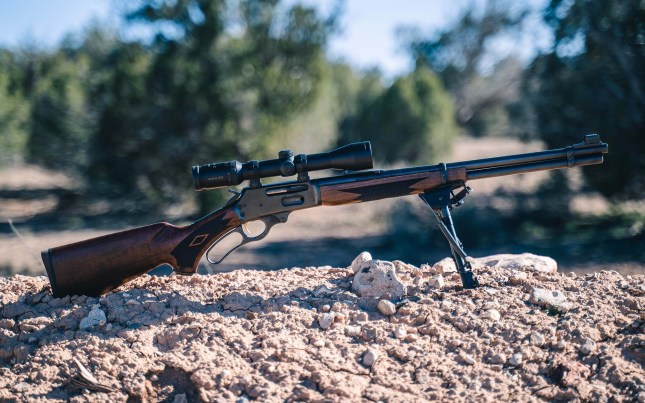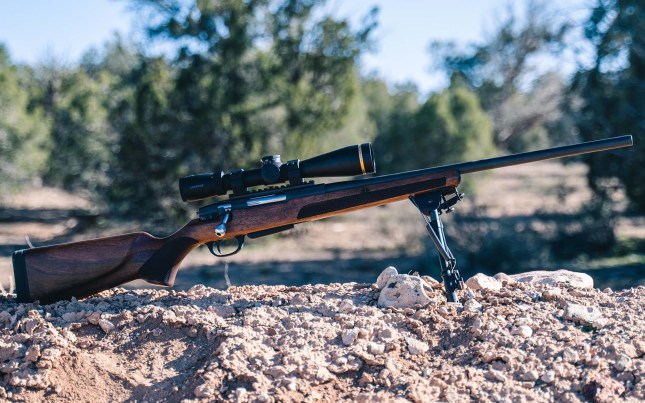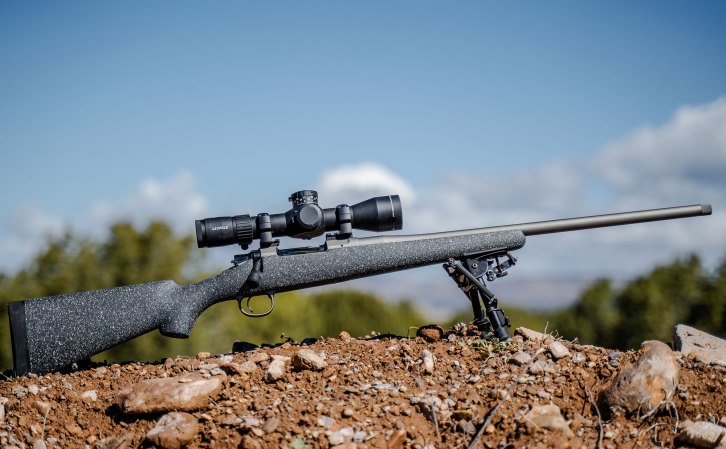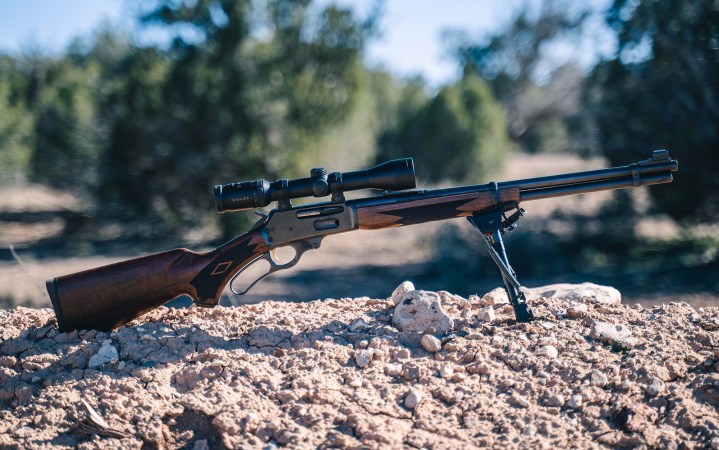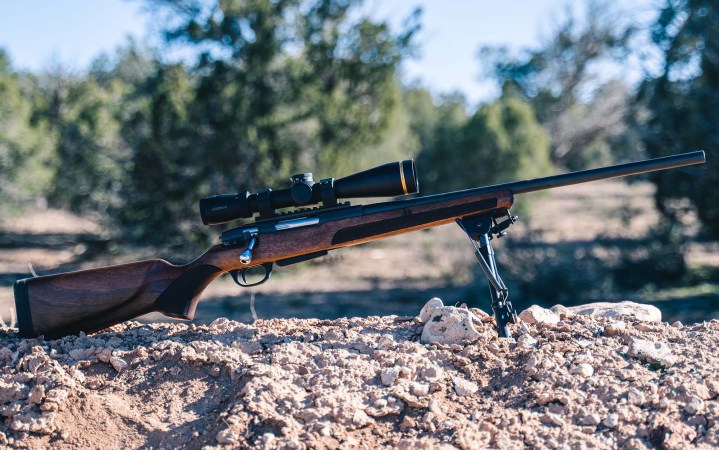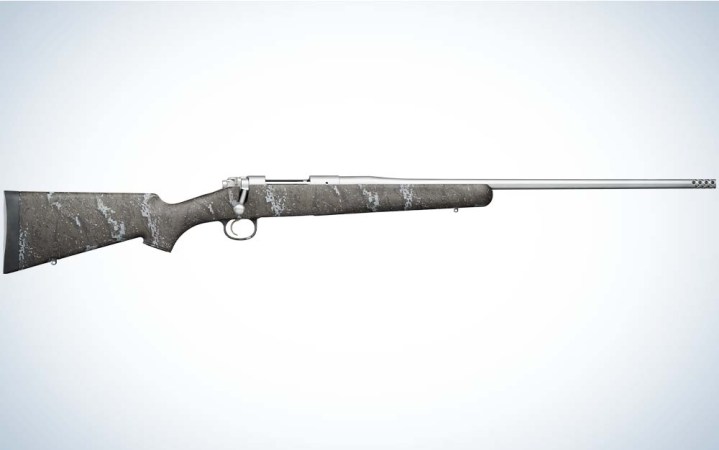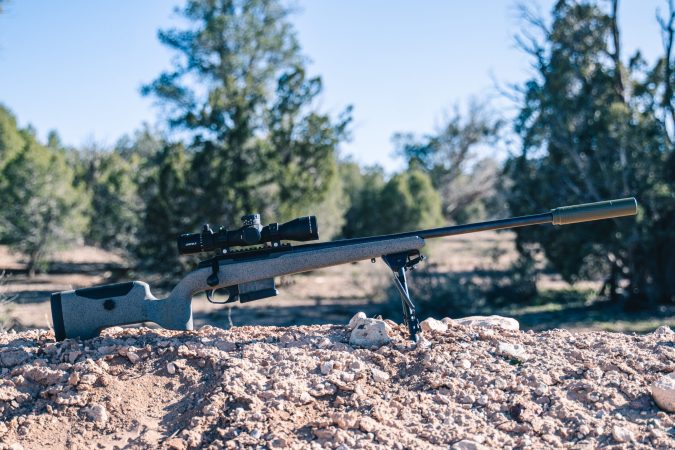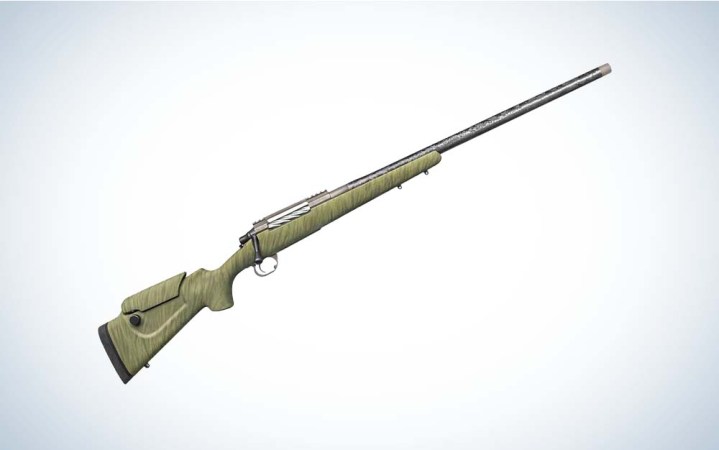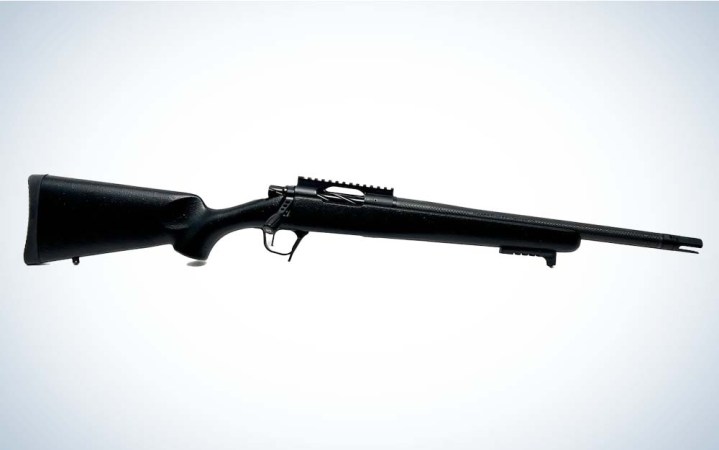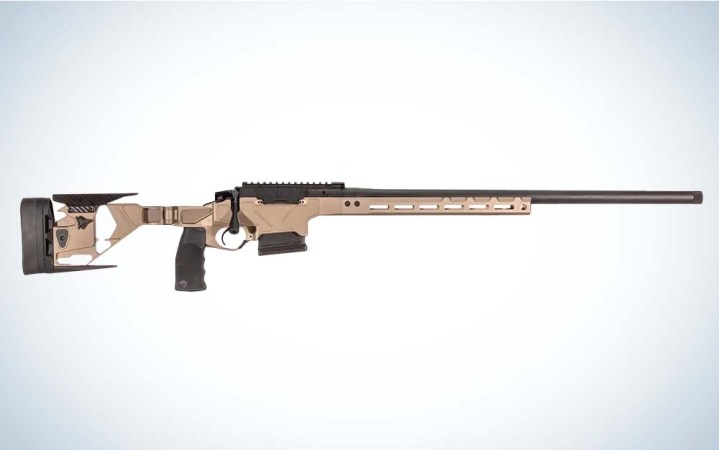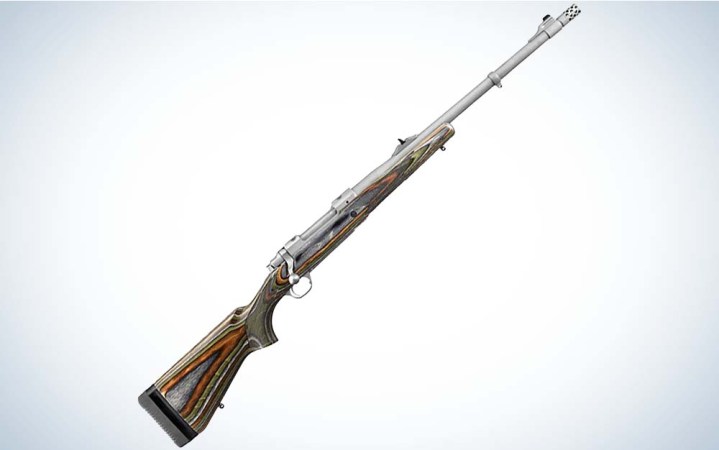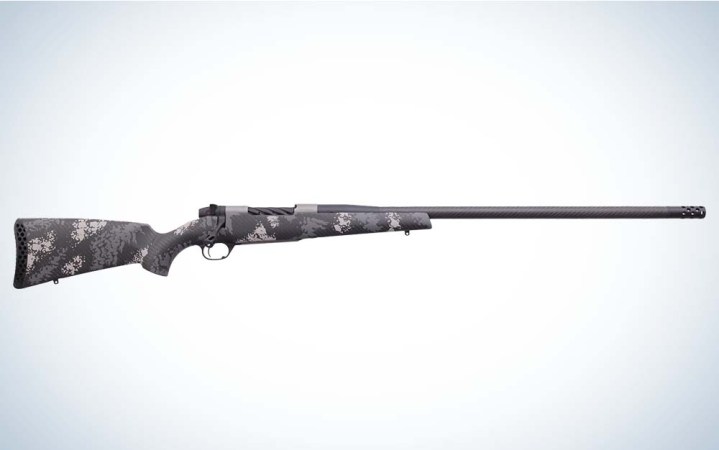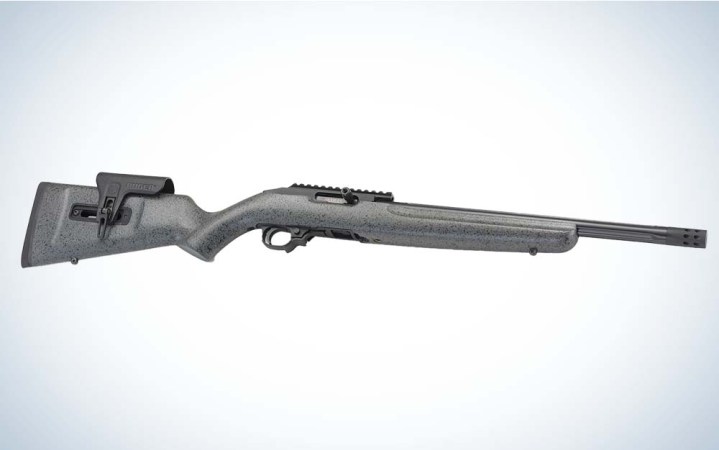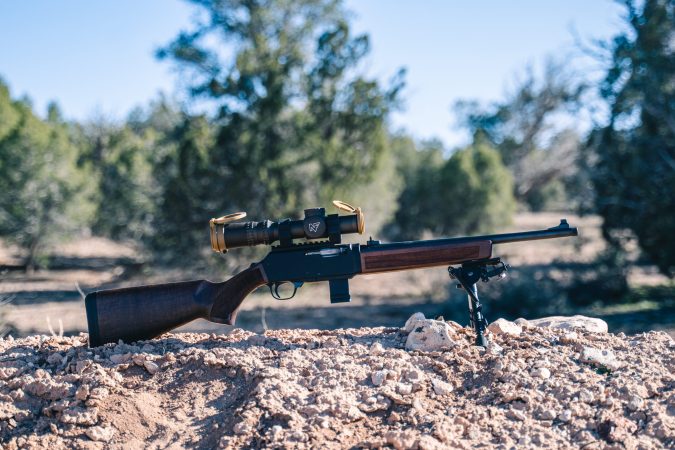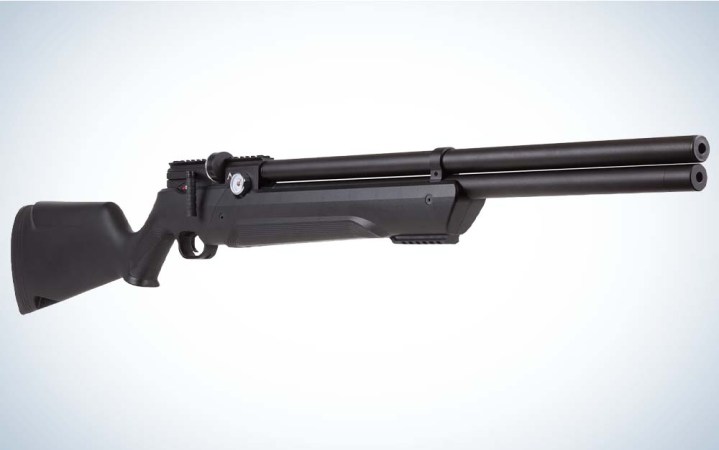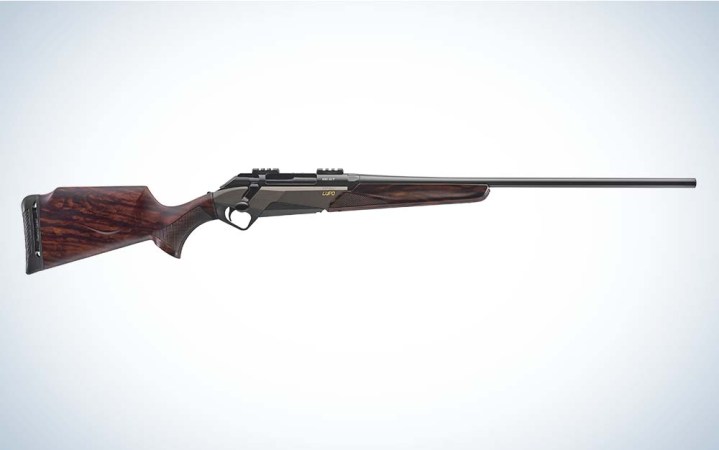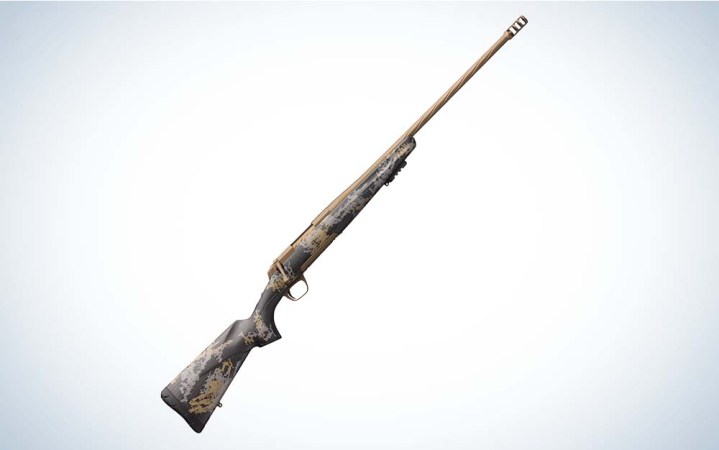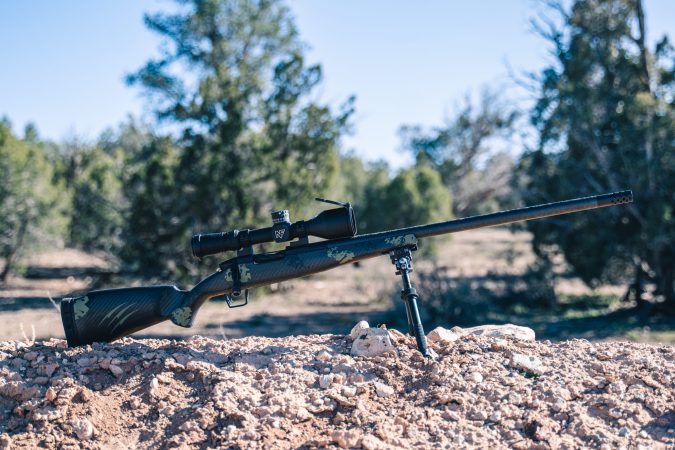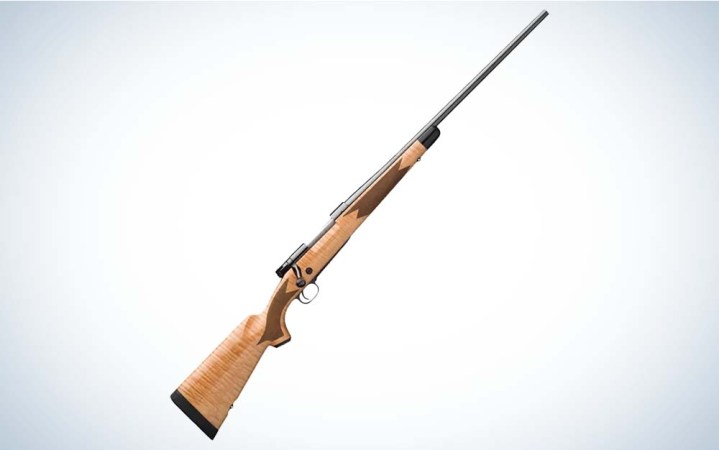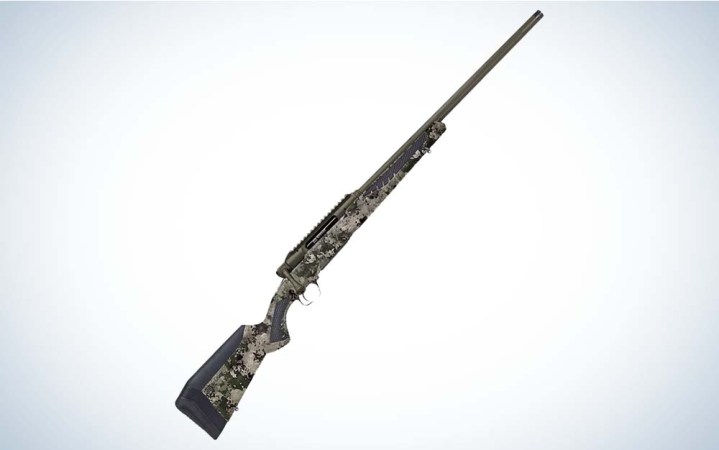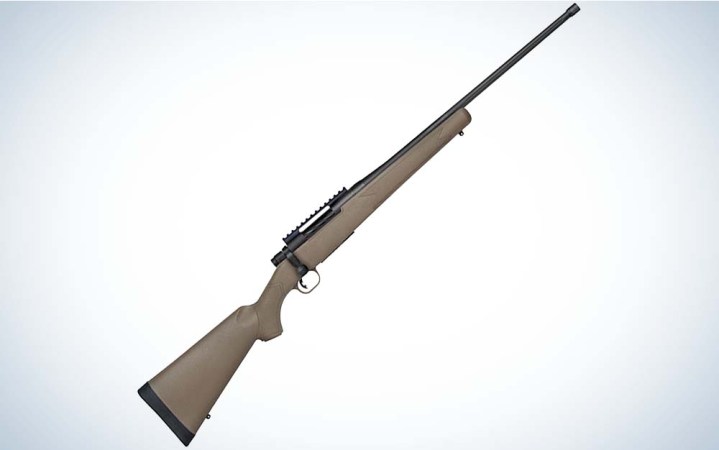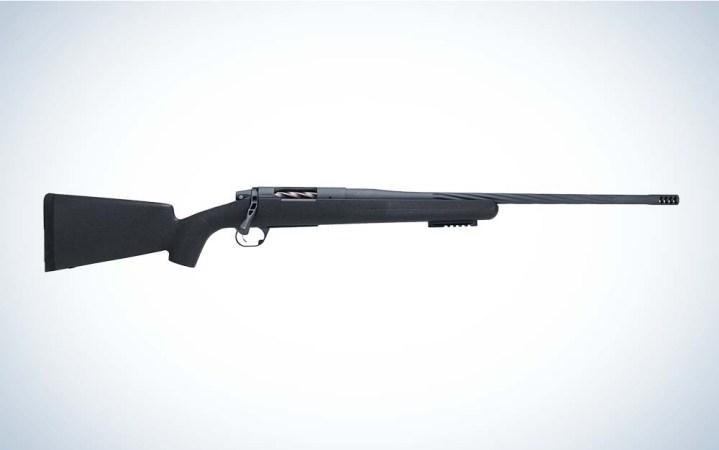We may earn revenue from the products available on this page and participate in affiliate programs. Learn More ›
The best hunting rifle for any outdoorsman needs to satisfy a trio of requirements. It must be suitable for the task at hand, mesh with your personal tastes, and fit within your budget. Of these, the first two are the most important. With respect to the third, that’s why the good lord invented payday loans.
Whether you hunt deer in the hardwoods, elk in the mountains, or bears in the Alaskan bush, there’s a hunting rifle for you. The landscape you hunt, your hunting style, and the game you chase will all influence your selection.
But there’s more to it than mere utilitarian concerns. Your rifle defines in part who you are as a hunter, whether it is a budget beater that lives in your truck for much of the year, an old-school lever action, or a pricey long-range hammer. We’ve made that task a little easier by narrowing down the field to the best hunting rifles we’ve tested.
- Best Overall: Nosler 21
- Best Lever Action: Marlin Classic 336
- Best Value: Stevens 334 Walnut
- Best Mid-Priced Rifle: Kimber Hunter Pro Desolve Blak
- Best NRL Hunter Rifle: Tikka T3X UPR
- Best Long Range: Proof Tundra
- Most Versatile: Christensen Arms Ridgeline Scout
- Best Long-Range Varmint Rifle: Seekins Havak HIT
- Best Bear Rifle: Ruger Guide Gun
- Best Mountain Rifle: Weatherby Mark V Backcountry 2.0 TI Carbon
- Best Rimfire: Ruger 10/22 Competition
- Best Plinker: Henry Homesteader
- Best Air Rifle: Air Venturi Avenger
How We Picked the Best Hunting Rifles
The list here includes many of the best rifles in our annual gun tests, the most in-depth (and honest) evaluation in the industry. But we’ve added in some of our personal favorite hunting rifles as well. These are guns that have proven themselves on the range and in the field—rifles that we are willing to stake the success of our hunts on, whether we’re headed to our family farm, hiking mountains, or crossing oceans in pursuit of game.
The Best Hunting Rifles: Reviews and Recommendations
Best Overall: Nosler 21
Key Features
- Caliber: 6.5 Creedmoor
- Weight: 6 pounds, 10 ounces
- Stock: Carbon fiber composite
- Barrel: 22 inches, threaded, 5/8-24
- Trigger: 4 pounds, 4 ounces, adjustable
- Price: Most models are around $2,500
Why It Made the Cut
The Nosler 21 is both a great performing rifle, and aesthetically pleasing. It’s accurate and superbly balanced.
Pros
- Great weight and balance
- Great price for the performance
- Very accurate
- Tool-less takedown for field serviceability
Cons
- Bolt handle could use a drop of thread locker
The Nosler 21 is a finely crafted bolt-action that won our 2022 Editor’s Choice award and remains the best all-around production hunting rifle you can buy.
At just under 7-pounds, the Nosler 21 it is wonderfully balanced and is built with a carbon fiber synthetic stock, stainless-steel Mack Brothers Evo action, and stainless-steel Shilen No. 3 contour barrel.
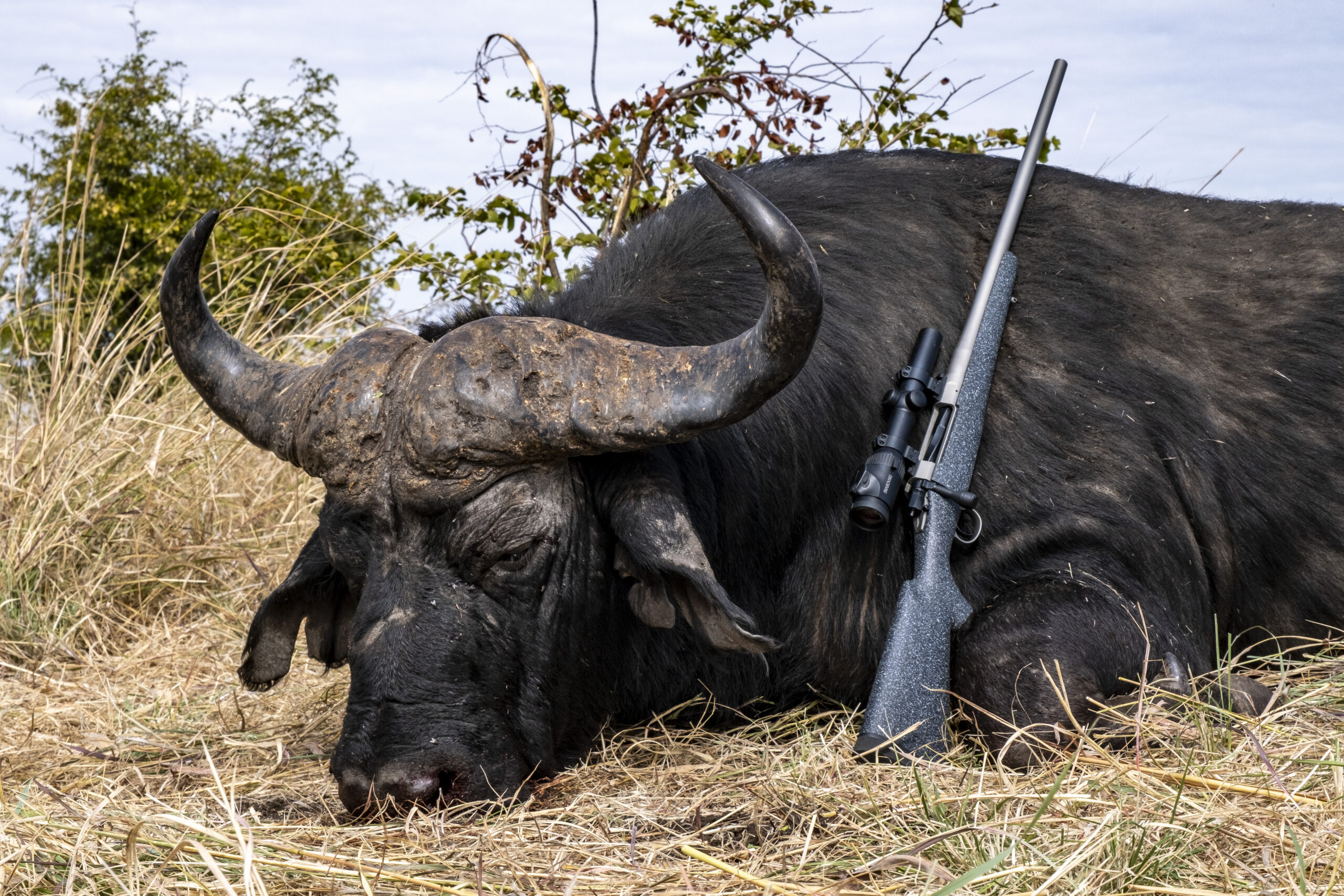
The carbon fiber stock is reinforced with Aramid, features a 1-inch recoil pad, and aluminum bedding pillars. Fit of the barreled action into the stock is nice and tight. The Mack Brother’s action on this rifle utilizes a two-lug bolt that features tool-less disassembly for cleaning and maintenance in the field.
With the action, adjustable Triggertech trigger, and Shilen barrel, this package delivers excellent accuracy, and out of the hundreds of 5-shot groups we fired in our gun test, this rifle shot the tightest one (0.266 in.). Even tested against more-expensive rifles, it was impossible to argue with the results the Nosler 21 produced. —T.F.
Best Lever Action: Marlin 336 Classic
Key Features
- Caliber: .30/30 Win. (.35 Remington later in 2023)
- Weight: 7 pounds, 1 ounce
- Stock: Walnut
- Barrel: 20 inches
- Trigger: 8 pounds
Why It Made the Cut
The Marlin 336 Classic marks the return of an iconic Northwoods deer rifle. Like other Ruger-made Marlins, the 336 Classic is among the finest lever-actions to carry the brand’s name.
Pros
- Superlative fit and finish
- Fast handling and well-balanced
- Reliable action
- Good accuracy
Cons
- Limited availability

This lovely rifle won over the hearts of the Outdoor Life gun test team this year, earning our coveted Editor’s Choice award in a stacked field of contenders.
The reason this old-school rifle-action and cartridge combination—which date to the late 1800s—managed such a feat is because they are so well made.
Historically, Marlins produced in Connecticut were built on antiquated machines operated by skilled gun makers, many of whom were third and fourth generation Marlin employees.
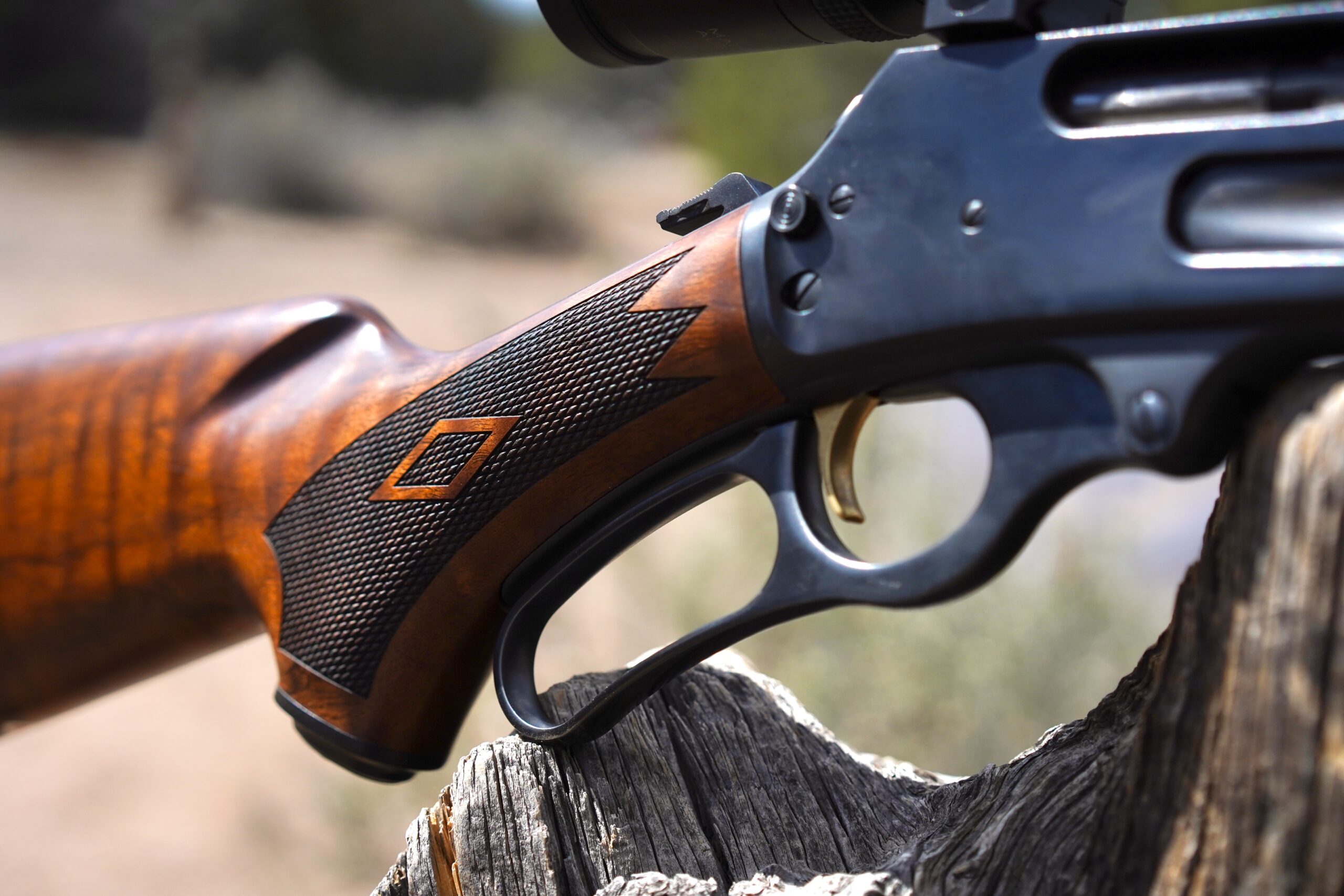
The lever actions they made required a lot of hand fitting and savvy that could only be acquired through long years of experience.
Today, Marlins are built on modern CNC machines that have removed the slop—and the need for such extensive hands-on gunsmithing—from the process. The result is the finest, tightest fitting, and highest quality production lever actions to wear the Marlin name and logo.
The action is smooth and everything on the rifle runs to perfection. The 336 Classic holds 6 rounds of .30/30 in its magazine tube and is able to accurately place them on target in rapid succession.
Our sample put five-shot groups on paper at 100 yards that averaged 1.627 inches, making it a legit 200-yard cartridge. It’s a good feeling knowing that this rifle can take full advantage of everything the .30/30 has to offer.
For anyone looking to go old-school with their deer (or elk or bear) hunting, this rifle is a fantastic choice. —J.B.S.
Best Value: Stevens 334 Walnut
Key Features
- Caliber: 6.5 CM
- Weight: 7 pounds, 14 ounces
- Stock: Walnut
- Barrel: 22 inches
- Trigger: 5 pounds, 10 ounces
Why It Made The Cut
Everyone likes affordable accuracy, and the Stevens 334 Walnut has that quality in spades.
Pros
- Affordable
- Accurate
- Good three-position safety
Cons
- Aesthetics reflect its price
The Stevens 334 Walnut was one of the biggest surprises of this year’s gun test. It is a basic wood-stocked bolt action imported from Turkey, and at first glance doesn’t seem to be anything special.
While the stock is nice enough, the metalwork and design of the action is basic—though in keeping with the rifle’s modest $489 price tag. After dry firing the trigger, you’d have no reason to anticipate any particular ballistic magic, either. The 5-pound, 10-ounce trigger has a bit of mush before it breaks.
But handsome is as handsome does, and the Stevens 334 charmed the entire test team once we started shooting it for accuracy. Its five-shot groups averaged less than ¾ MOA, making it one of the most accurate rifles of the test.
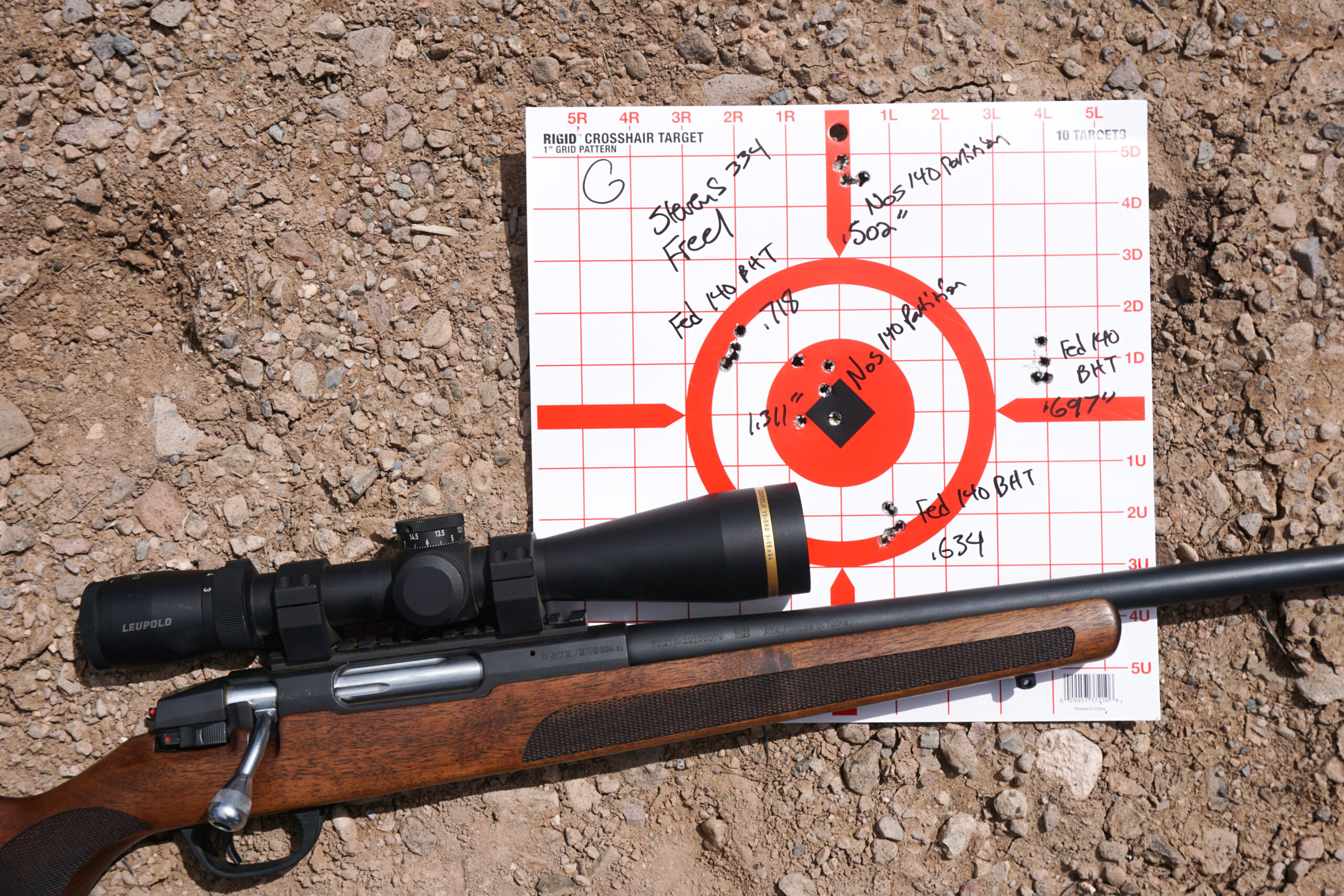
It shoots way better than it has any right to, was our collective takeaway.
It has other features we liked as well. The three-position safety locks the bolt down when fully engaged, while the central position lets the shooter clear or check the chamber without putting the gun on “fire.”
The polymer single-stack magazine loads easily and holds three rounds of 6.5 Creedmoor, though the rifle is also available in .308 Win. and .243 Win.
The three-lug design, with its 60-degree bolt lift, is surprisingly smooth and easy to operate from the shoulder. It comes with a Picatinny rail that runs the full length of the action which makes mounting an optic a snap.
In sum, the Stevens 334 Walnut is a wonderful rifle for the price, which is why it won the Great Buy award winner in the hunting rifle category in 2023. —J.B.S.
Best Mid-Priced Rifle: Kimber Hunter Pro Desolve Blak
Key Features
- Caliber: .308 Win.
- Weight: 5 pounds, 7 ounces
- Stock: Fiber-reinforced polymer
- Barrel: 22 inches, threaded 7/16-28
- Trigger: 4 pounds, 1 ounce
- Price: $829
Why It Made The Cut
This versatile and good-looking rifle can handle most hunting chores and is one of the nicest rifles made under $1,000.
Pros
- Lightweight
- Great ergonomics
- Versatile
- Decent accuracy
Cons
- Barrel heats quickly
This lovely little number won top honors in our roundup of the best mid-priced rifles. The M84 action that it uses has some features that appeal to traditionalists. It is controlled round feed, for starters, and takes its cues from the pre-’64 Winchester Model 70s and Mauser actions but is significantly slimmed down.
It incorporates a fixed-blade ejector that allows the shooter to control the force with which the brass exits the action based on how hard the bolt is run.
It also has a three-position wing safety on the bolt shroud which is one of the best—and most classic—safeties ever devised.
This rifle is light enough to hunt the mountains but is accurate enough that it can hang with heavier-barreled deer guns—at least for the first three rounds. Like other Kimbers it comes with a three-shot sub-MOA guarantee and our sample easily met that standard. But when putting five shoots in quick succession through it the groups tended to open up, which isn’t surprising on a featherweight rifle wearing a svelte barrel.
Still, ours managed a 1.37-inch average 5-shot group size for the ten best groups we put through it—which is solid performance from what is essentially a bargain priced mountain rifle. Our sample was chambered in .308 Win., but it is also available in 6.5 Creedmoor. —J.B.S.
Best NRL Hunter Rifle: Tikka T3X UPR
Key Features
- Caliber: 6.5 Creedmoor
- Weight: 7 pounds, 14 ounces
- Stock: Synthetic, with adjustable cheek piece
- Barrel: 22 inches, threaded, 5/8-24
- Trigger: 3 pound, 13 ounces, adjustable
- Price: $1,299
Why It Made the Cut
A great cross-over rifle for big game and NRL Hunter competition that is supremely accurate
Pros
- Great accuracy
- Wonderful ergonomics
- Slick, reliable action
Cons
- A bit heavy
The NRL Hunter competition series has taken off in the last couple years as a hunter-oriented shooting sport. The appeal is that a shooter can take a standard deer rifle and be competitive without the need to invest thousands of dollars in arcane gear that has no application during hunting season.
In the “factory” division— where a rifle can’t weight more than 12 pounds with scope and added accessories—the Tikka T3X is one of the most popular choices. The UPR (ultimate precision rifle) model in 6.5 Creedmoor is the cream of the crop.
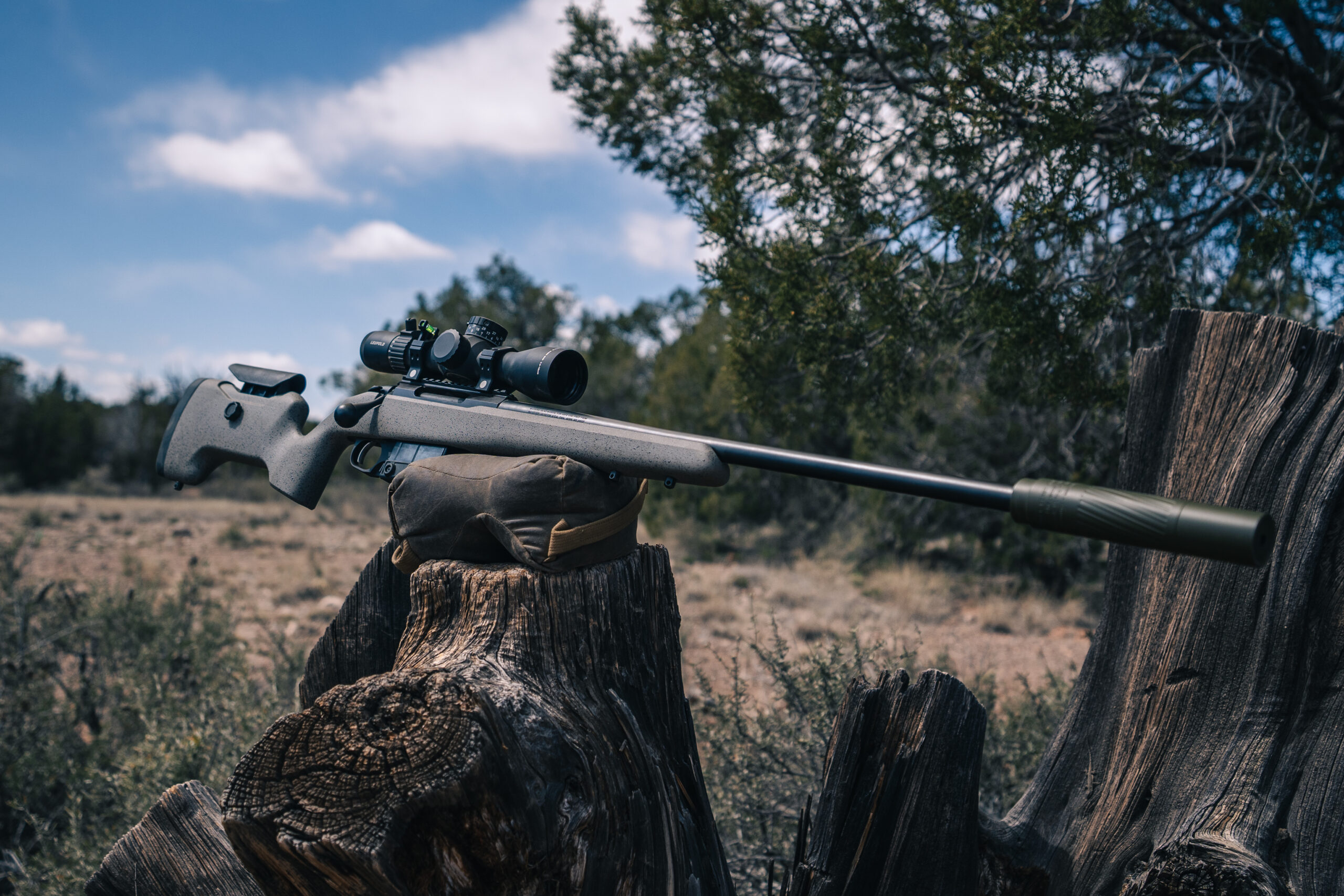
Mine shoots factory Hornady 140-grain ELD-M bullets like nobody’s business. Topped with a Leupold Mark 5HD 3.5-18×44 (incidentally the most popular scope in the factory division) it averages .677-inch 5-shot groups, which is more than accurate enough to win any NRL competition. You can see my full review of the Tikka T3x UPR here.
Even shooting hunting ammunition, like Federal’s excellent 135-grain Berger Hybrid Hunter bullet, or the tried-and-true Hornady 143-grain ELD-X, it shoots to that same level of precision.The action is remarkably smooth, the stock’s ergonomics—as with all Sako and Tikka rifles—are excellent, and its reliability is such that putting 200-rounds through it over the course of a two-day match won’t bother it in the least. —J.B.S.
Best Long Range: Proof Tundra
Key Features
- Caliber: 6.5 CM
- Weight: 7 pounds, 2 ounces
- Stock: Carbon-fiber composite
- Barrel: 24 inches, threaded, 5/8-24
- Trigger: 2 pounds, 10 ounces, adjustable
- Price: $7,799
Why It Made the Cut
The Proof Tundra is top-notch when it comes to materials, manufacturing, fit and finish, and accuracy. It was the most accurate hunting rifle of the 2022 Outdoor Life Gun test.
Pros
- High-quality materials and fit of all components
- Adjustable trigger
- Carbon-fiber adjustable cheek piece
- Accurate
Cons
- Expensive
Proof’s Tundra is the barrel-maker’s own semi-custom hunting rifle designed to maximize looks and performance in almost every category. It features a carbon-fiber stock with adjustable carbon fiber cheek piece, into which a Proof carbon fiber-wrapped barrel and the Defiance two-lug bolt action are perfectly fit and bedded. Our sample came in a silver-on-black netting-style finish, but a variety of options are available.
The Tundra is a price-be-damned rifle that exhibits excellent craftsmanship and performance. The fit and attention to detail was unmatched among the competition in our 2022 gun test. The combination of the rifle’s features—from the top-loading BDL-style magazine, to the lightweight stock with an adjustable cheek-piece— has resulted in one of the best rifles for long-range hunting you can find.

The Tundra comes with a 3-shot, ½ MOA accuracy guarantee, which it easily achieves. During our evaluation its 5-shot groups averaged .683 inches—which was only bested by the two precision competition rifles in the test. The Tundra has excellent balance and is light enough to not be an encumbrance on any hunt. —T.F.
Most Versatile: Christensen Arms Ridgeline Scout
Key Features
- Caliber: 6.5 CM
- Weight: 5 pounds, 14 ounces
- Stock: Carbon-fiber composite
- Barrel: 16 inches, carbon-fiber, 5/8-24 threaded
- Trigger: 2 pounds, 1 ounce, adjustable
- Price: About $2,100
Why It Made the Cut
The Christensen Arms Ridgeline Scout is a short, handy rifle that can do just about anything, whether it’s hunting hogs in the brush or sheep in the mountains.
Pros
- Short, handy, and well-balanced
- Uses AICS-pattern magazines
- Suppressor or muzzle-device-ready
- Great accuracy
Cons
- Flat trigger shoe doesn’t fit well with grip angle

An ode to the scout rifle concept pioneered by Jeff Cooper, the Christensen Arms Ridgeline Scout is a light and versatile bolt action. It features a black nitride-coated action with a two-lug bolt and skeletonized bolt handle. The carbon-fiber stock is slim with classic lines but includes a section of rail that incorporates a barricade stop at the front of the forend for attaching a bipod. Under the hood, the stock incorporates stainless steel bedding pillars.
The action includes a rail optics mount and over-sized magazine release and is compatible with AICS-pattern magazines—both polymer and steel. It has a 16-inch threaded carbon-fiber barrel that comes with a 3-prong flash suppressor but would make a perfect host for a suppressor.
The Ridgeline Scout is short, but accurate. In our 2022 gun test, it averaged .784-inch 5-shot groups—even better than the 3-shot sub-MOA guarantee. The only thing we weren’t fans of was the fit of the flat trigger shoe with the classic-style sporter grip angle— a curved trigger shoe would be a better choice with the stock’s geometry.
The rifle’s handiness and accuracy make it more-than-ideal for a number of tasks ranging from a ranch rifle to an NRL hunter competition gun, and just about anything in-between. It would be just as at-home in a Midwest deer stand as it would be spot-and-stalk hunting black bears on the beaches of Prince William’s Sound. —T.F.
Best Long-Range Varmint Rifle: Seekins Havak HIT
Key Features
- Caliber: 6.5 PRC
- Weight: 11.5 pounds
- Stock: Seekins folding aluminum chassis
- Barrel: 24-inch threaded 5/8-24
- Trigger: 2 pounds, 8 ounces, adjustable
- Price: Around $2,000
Why It Made the Cut
The Havak HIT is an incredibly innovative, versatile, and accurate precision rifle—all at a great price.
Pros
- Extremely accurate
- Switch-barrel and cartridge capability
- Adjustable trigger
- Great Price
Cons
- Doesn’t have integral ARCA rail on chassis
The Seekins Havak HIT was one of the stars of our 2022 Gun test. It was one of the most accurate rifles we shot—second only to the Accuracy International AT-X, and not by much. The Havak HIT we received in 6.5 PRC printed 5-shot groups that averaged .542 inches. It received both a Best Value and Innovation Award—a rare and well-deserved double win.
The Havak HIT action and chassis are entirely unique to Seekins Precision. The only non-proprietary component is the trigger, which is a Remington 700-pattern adjustable trigger. The aluminum chassis features easy comb and length-of-pull adjustments, and has a folding stock, AR-style vertical grip, and compatibility with AICS magazines. The only thing it lacks is an ARCA rail, though one can be added to the fore-end.
The switch-barrel system is a big part of the rifle’s innovation. By loosening a set screw, the barrel can be removed and replaced, and only the bolt head needs to be swapped out to shoot a different caliber. Weight can be added to the rifle for stability in competition, but as-is, it makes an excellent long-range varmint rifle and is chambered in light-recoiling long-range cartridges like the 6 Creed and 6 GT. —T.F.
Best Bear Rifle: Ruger Guide Gun
Key Features
- Caliber: .338 Win. Mag.
- Weight: 8 pounds
- Stock: Green Laminate Wood
- Barrel: 20 inches, stainless-steel, threaded, 5/8-18
- Trigger: 4 pounds, 2 ounces
- Price: Around $1,300
Why It Made the Cut
When it comes to coercing bears out of the brush, the Ruger Guide Gun is hard to beat. It’s short, handy, and chambered in several heavy-hitting calibers.
Pros
- 20-inch barrel is handy in the brush
- Includes muzzle brake and equally-weighted thread protector
- Mauser-style controlled-feed action and fixed ejector
- Length-of-pull is adjustable with included stock spacers
Cons
- Shorter barrel gives up some velocity
Ruger’s Guide Gun—an adaptation of their long-successful M77 action—is one of the best bear rifles out there when it comes to dealing with them at close range. As the name suggests, the idea behind the Guide Gun is as a bear-stopping rifle in tight quarters when it really hits the fan.
The Guide Gun is a simple rifle, essentially a short-barreled M77 that’s designed to be quick, handy, and powerful. The Mauser-style controlled feed action is ultra-dependable and only gets smoother with age and use. It features a fixed (not spring-powered) ejector for reliable ejection that only gets more powerful the harder you stroke the action. The action also features a non-rotating extractor, 3-position safety, and Ruger’s proprietary integral scope bases.
The green laminate wood stock is heavy but designed to withstand the weather and heavy recoil—it features a soft rubber butt pad and optional spacers to change the length-of-pull. The action and barrel are stainless-steel, and the barrel is fitted with a sling swivel stud barrel band and express-style iron sights. The muzzle is threaded, but each caliber is threaded in pitches that aren’t compatible with typical suppressor adapters. The rifle comes with a removable radial muzzle brake, matching-weight thread protector, and smaller thread protector.

I’ve long used the M77 platform for bear backup rifles, and the Guide Gun is the handiest one of them yet. It’s offered in .30/06, .338 Win. Mag., .375 Ruger, and .416 Ruger—all great options. I recently killed a grizzly coming towards me at 15 yards with mine chambered in .338 Win. Mag. —T.F.
Best Mountain Rifle: Weatherby Mark V Backcountry 2.0 TI Carbon
Key Features
- Caliber: 6.5 CM
- Weight: 5 pounds, 2 ounces
- Stock: Carbon-fiber composite
- Barrel: 24 inches, carbon-fiber, threaded
- Trigger: 3 pounds, 4 ounces, adjustable
- Price: Around $3,500
Why It Made the Cut
The bottom line when it comes to mountain rifles is weight, and the Backcountry 2.0 TI Carbon excels while bringing the performance needed to instill confidence on the mountain.
Pros
- Lightweight
- 24-inch carbon-fiber barrel is accurate and strong
- Great ergonomics
- Short bolt throw
Cons
- Titanium action is a little sticky
- Fit and finish could be better considering price tag
The Mark V Backcountry 2.0 TI Carbon is an update to Weatherby’s original Backcountry series, which focuses on lightening up the famous Mark V action and producing a truly ultralight mountain rifle. For the 2.0, a couple key upgrades are the option for a carbon-fiber barrel and a re-design of the 3D-printed recoil pad (the original would hold a smashed-down shape when the rifle was rested on the recoil pad).
The Backcountry 2.0 TI Carbon features the 6-lug Mark V action, which uses 2 rows of 3 lugs for a light, but strong action tailored to Weatherby’s rebated rim cartridges. The titanium action and carbon-fiber barrel help to achieve an impressively low weight of just over 5 pounds with the 24-inch-barreled 6.5 CM we tested. The short bolt throw makes cycling the gun a pleasure, and although titanium actions tend to be sticky, it’s a worthwhile compromise in this case.
The full carbon-fiber stock adds rigidity at a minimal weight penalty and although we feel some of the fit and finish could be improved, it has a very comfortable grip and grip angle. Light rifles can be difficult to shoot well, and the ergonomics of this rifle helped. It shot pretty well across a variety of loads in our 2022 gun test, and the average of our best ten 5-shot groups was .824 inches. We did notice that the groups started to open up as the gun warmed up—especially on the fifth shot—but for most mountain hunting situations, it’s that first one or two that really matter. —T.F.
Read Next: Weatherby Mark V Hunter Review
Best Rimfire: Ruger 10/22 Competition
Key Features
- Caliber: .22 LR
- Weight: 6 lb. 3 oz.
- Stock: Synthetic with adj. cheek piece
- Barrel: 16.12 in., threaded ½-28 with muzzle brake
- Trigger: 2 lb. 14 oz.
- Price: $929
Why It Made the Cut
A do-everything rimfire that comes in a left-handed configuration.
Pros
- Great trigger
- Good fit and finish
- Accurate
- Utterly reliable
Cons
- Spendy
The Ruger 10/22 has come out in more variations than the IPAs at your local brewery. This iteration is from the Custom Shop and is one of the most refined 10/22s to date.
It takes the classic 10/22 action—the 350 Chevy short block of rimfires—and tricks it out with a series of upgrades to create a high-performance, grown-up .22 LR. And in a nod to all the wrong-handed folks out there, Ruger is offering it in a lefty version as well.
The trigger on my sample is outstanding, breaking at a crisp and consistent 2 pounds 14 ounces. Combined with the hammer-forged barrel, it delivers excellent accuracy at 50 yards. To help with the rifle’s long-range potential, the action is topped with a 30 MOA Picatinny rail for mounting optics.
Being a 10/22, it would be a chore to make the gun not shoot well, and it runs like crazy, digesting every type of .22 LR I stuffed into its 10-round rotary magazines.
The Competition model has an ergonomic mag release integrated into the trigger guard that is easy to manipulate and relatively unobtrusive. The attention to ergonomics extends to the stock which has an adjustable cheek piece that goes up and down and can slide fore and aft with a single throw lever. As handy as that feature is, the hardware is a bit clunky looking and it is the one aesthetic sore spot on the rifle.
Everything else on the 10/22 competition is nicely finished. The barrel is fluted and comes with a racy and effective muzzle brake. The laminate stock has an attractive speckled gray coating that provides a bit of grip. And the fore-end has a beaver-tail-like contour that is comfortable and gives a good purchase.
One thing to know is that if you do opt for the left-handed model, regular right-handed 10/22 magazine won’t work. The lefty rotary mags spool up the other way. —J.B.S.
Best Plinker: Henry Homesteader
Key Features
- Caliber: 9mm Parabellum
- Weight: 6 pounds, 10 ounces
- Stock: Walnut
- Barrel: 16.37 in., threaded ½-28
- Trigger: 6 pounds, 10 ounces
- Price: $928
Why It Made the Cut
This fun, versatile truck gun takes popular magazines from Sig, Glock and Smith & Wesson and is one of the most enjoyable PCCs around.
Pros
- Takes common pistol magazines
- Simple design makes it utterly reliable
- Runs on cheap ammo
Cons
- Isn’t inexpensive
The fun factor of the Henry Homesteader is undeniable. This simple 9mm PCC, which operates from standard pistol magazines on a blowback design, quickly established itself as an Outdoor Life test team favorite.
It is reasonably accurate, has negligible recoil, doesn’t cost a ton, is super handy, and fires cheap ammo. What’s not to like? I wrote about the Homesteader at some length after I first got it, and it turned out that the other judges at this year’s gun test shared my positive impression.
We ran the rifle a lot on Gunsite’s famed Scrambler, where it was right at home ringing the steel targets that are about 50 to 100 yards downrange. It functioned flawlessly here and throughout the week-long evaluation.
The team was split on the looks of the blocky fore-end. It reminded me of my old Crossman 7600 BB gun as a kid and brought images of the M1 Thompson to another judge, good associations both. Another judge thought it could benefit from a bit of contouring.
No matter what you think of its aesthetics, as a pure plinker it is at the top of the class. It’s also one of the most enjoyable guns you could choose for hunting brushpile rabbits or varmints. —J.B.S.
Best Air Rifle: Air Venturi Avenger
Key Features
- Regulated
- Adjustable Trigger
- Max Fill Pressure: 4,350 psi
- Shrouded barrel
- 900 fps in .25 caliber
- About 20 shots per fill (depending on tune)
- Weight: 6.4 pounds
- Price: $350
Why It Made the Cut
The Air Venturi Avenger has excellent accuracy, power, and shot-to-shot consistency.
Pros
- Accurate
- Consistent velocity
- Handles well in the field
- Quiet
Cons
- Requires a pump, tank, or compressor to fill
In a time when ammo is still hard to come by, an air rifle is an attractive alternative because pellets are readily available and even a few bucks cheaper than bulk .22 LR ammo. I recommend skipping past the pump and spring pellet guns you’re probably familiar with, and instead jumping into pre-charged pneumatic air rifles. PCPs use a pressurized air tank that is filled via a hand pump, compressor, or scuba tank. The main advantage is that the air power source makes them more accurate, powerful, and easier to shoot. They also don’t need special scopes that spring air rifles require.
The best PCP airgun to get started with is the Air Venturi Avenger, an impressively accurate, affordable air rifle. Airgun expert, Jim Chapman, chose it as one of the best air rifles, and as Avenger owner myself, I agree. In Champan’s Avenger review his rifle had just a 19 fps variation over a 30 shot string. That consistency is reflected in the rifle’s accuracy—my Avenger shoots ¼ inch groups at 25 yards. It’s also a fairly quiet airgun, which is nice for introducing new shooters, backyard pest control, and basement ranges.
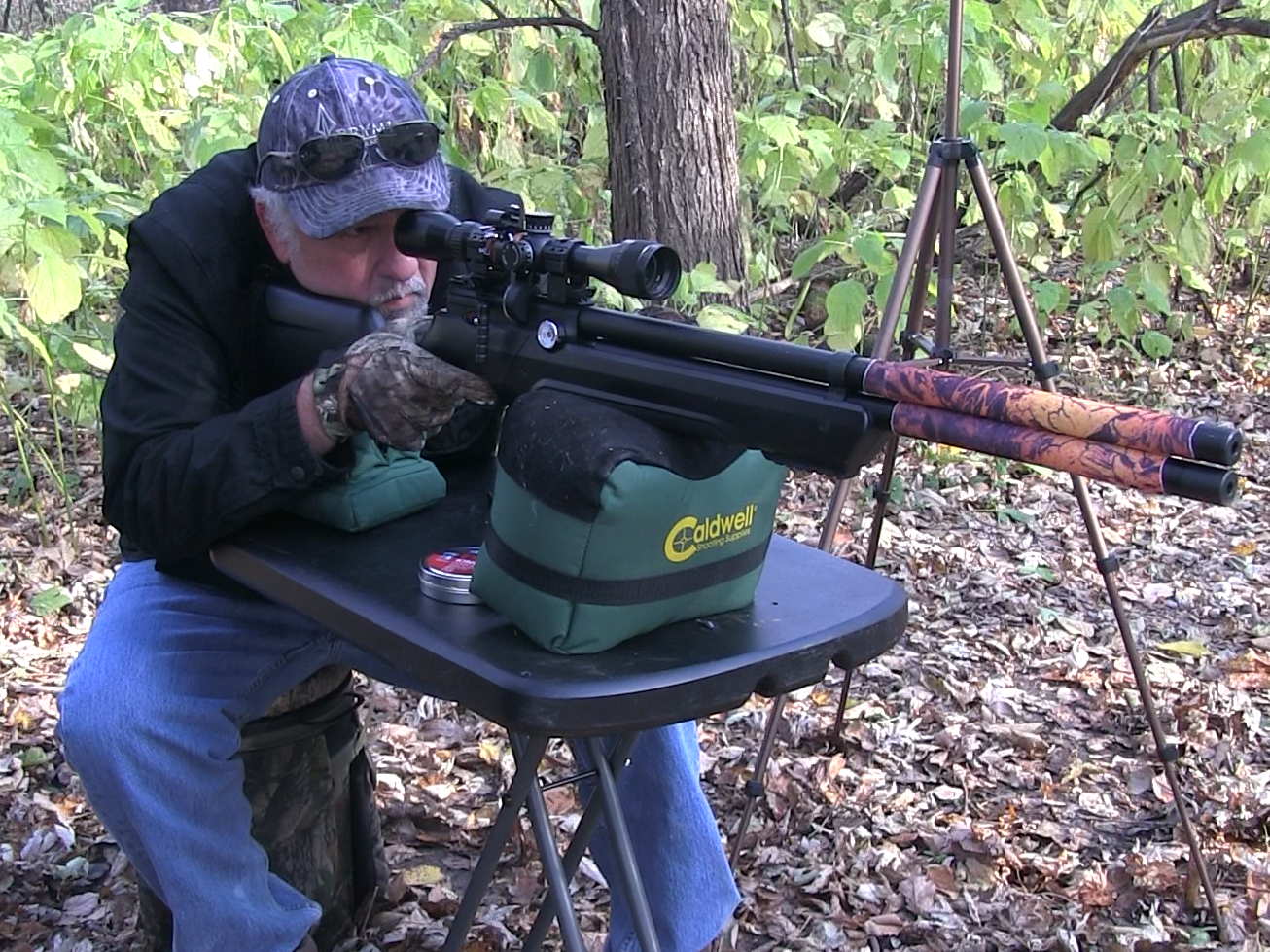
This sub $400 air rifle has features you’d typically only find on top-tier guns. One of those is that it’s regulated. This means that you can set the regulator to a specific psi and it will shoot every shot at that exact psi until the pressure drops below the setting. As a result, you get drastically improved consistency over an unregulated gun in which the pressure changes with each subsequent shot. This also allows the gun to be fine-tuned to work with a specific projectile or for a specific application. —S.E.
Other Top Rifles
Benelli Lupo Limited Edition
Key Features
- Caliber: 6.5 CM
- Weight: 7 pounds, 6 ounces
- Stock: Walnut
- Barrel: 24-inches, threaded 5/8-24
- Trigger: 2 pounds, 8 ounces
Why It Made the Cut
The Lupo Limited Edition is a fast-handling, sleek hunting rifle with an elegant European feel that’s made to be fired offhand.
Pros
- Excellent handling characteristics
- Two-position safety is quick and comfortable to operate
- Customizable stock fit
- Great-looking wood, lines, and finish
Cons
- No sling swivel studs
The Benelli Lupo Limited Edition is a 3-lug bolt-action that feeds from a flush-fitting detachable box magazine. It has sleek, futuristic lines and feels utterly European in its design and handling characteristics. It’s a rifle that was made to be shot from standing or kneeling positions, and walking or driven hunts are where this rifle would be most at-home.
The rifle features a handsome walnut stock and forend that are finished to look high-class, and blend well with the bright finish of the steel. The sharp angles of the trigger guard look like what you’d see on a shotgun, but the grip angle, contour, and location give the shooter a nearly perfect finger position for the trigger—the rifle is very comfortable and intuitive to shoot.
Although the bright-blued-looking finish might turn off some harsh-weather hunters, it’s treated with Benelli’s proprietary surface treatment (acronym BE.S.T.), we just wish they didn’t print “BE.S.T.” in bold letters on the otherwise sleek and elegant-looking receiver. —T.F.
Browning X-Bolt Mountain Pro
Key Features
- Caliber: 6.8 Western
- Weight: 6 pounds, 4 ounces
- Stock: Foam-filled carbon-fiber
- Barrel: 24 inches, threaded, 5/8-24
- Trigger: 3 pounds, 5 ounces, adjustable
Why It Made the Cut
The Browning X-bolt is an accurate, dependable, and capable hunting rifle—and the Mountain Pro is the most-optimized version yet.
Pros
- Lightweight
- Well-balanced
- Muzzle brake and thread protector included
- Short bolt-throw for quick, smooth cycling
Cons
- Good, but not stellar accuracy for the price
The X-bolt has firmly established itself as a go-to platform for Browning—and for good reason. The rifles are consistently good-shooters, reasonably lightweight, well-balanced, and dependable. The Mountain Pro is the latest iteration of this platform, and one of the best.
Optimized for mountain hunting, the new Mountain Pro features a fluted steel barrel, bolt, and bolt handle, a foam-filled carbon-fiber stock, and bronze or tungsten-colored cerakote finish on all parts. It’s of course built on the smooth-running short-throw X-bolt action that’s fed from a detachable rotary magazine.
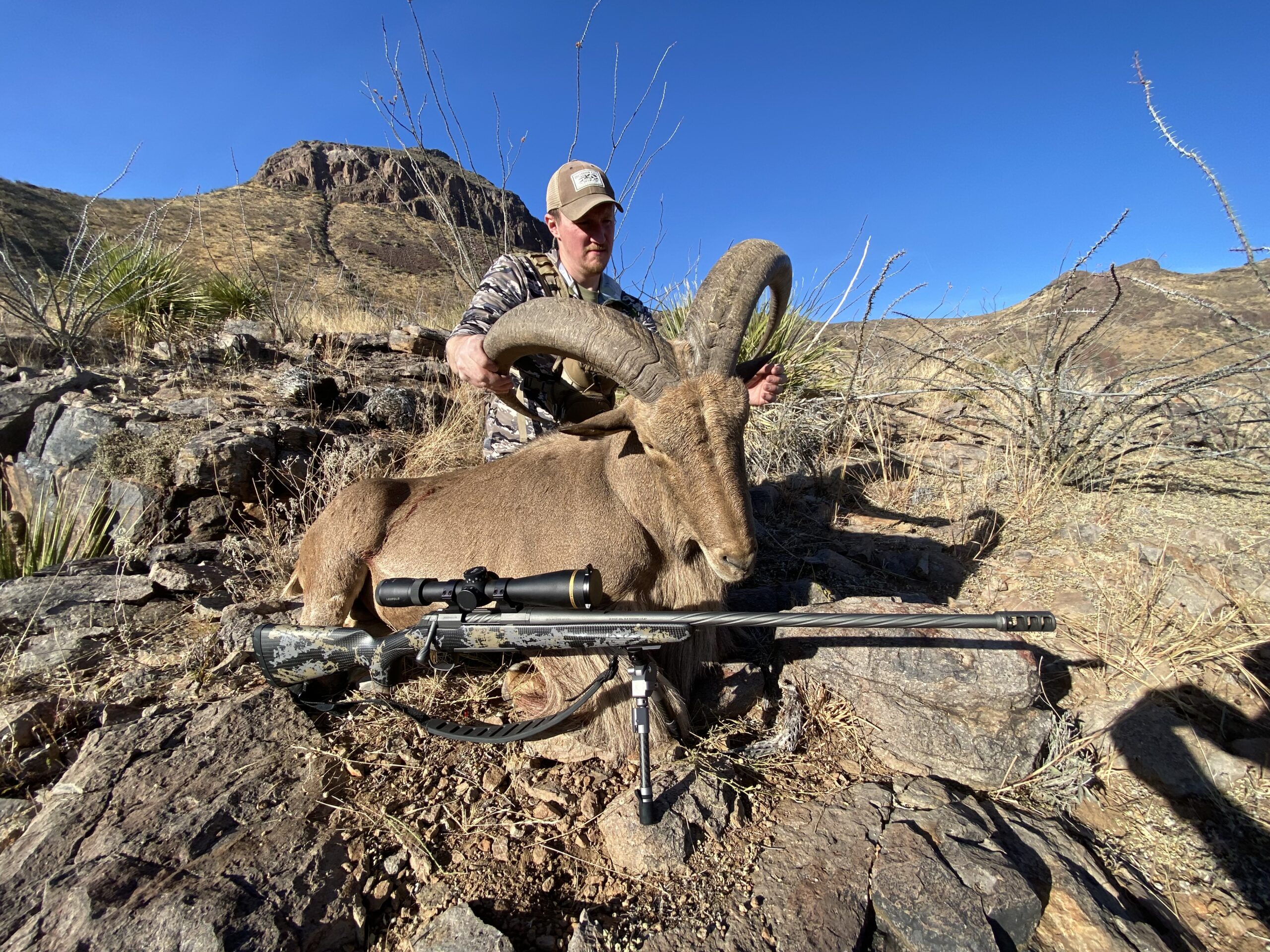
The Stock on the Mountain Pro is light and tough, with a nicely contoured grip swell and comfortable grip angle. It’s an easy rifle to shoot and has great balance for carrying up the mountain one-handed. It has an intuitive tang safety and a generally good trigger. Compared to many popular titanium actions, the steel X-bolt action is slick and fast with its short throw.
Accuracy of the X-bolt’s is generally good, and in my testing at temperatures of -10 to -20 degrees, my Mountain Pro averaged 1.18-inch 5-shot groups with Browning’s Long Range Pro 175-grain Tipped Game King load. The accuracy didn’t wow me, but I wasn’t disappointed either. In November of 2021, I placed 3 shots in a group the size of a baseball at 420 yards on a West Texas aoudad. —T.F.
Fierce Firearms Carbon Rogue
Key Features
- Caliber: 6.5 PRC
- Weight: 6 pounds, 4 ounces
- Stock: Carbon fiber
- Barrel: 24 inches, threaded 5/8-24
- Trigger: 3 pounds, 1 ounce
- Price: $2,199
Why It Made The Cut
Company owner John Mogle wanted to make his excellent rifles more attainable for regular folks—and the Carbon Rogue does just that.
Pros
- Great ergonomics
- Excellent fit and finish
- Good value for the feature set
Cons
- Our sample had minor feeding issues
We’ve gushed about the high-end rifles that Fierce Firearms makes in the past, but one thing about high-end rifles is that they come with high-end prices. The Carbon Rogue, while not a budget gun, costs significantly less than the company’s other models, yet still brings a lot of excellent features to the table.
With its carbon-fiber barrel and carbon-fiber stock the rifle tips the scales at 6 pounds, 4 ounces which puts it in a sweet spot in terms of how easy it is to carry versus how it balances and handles.
The shape of the stock is well done, too, making the Carbon Rogue easy to run from the prone and other positions while remaining lively during dynamic drills. We also really like the recessed section of Picatinny rail on the front of the fore-end and the QD cup attachment points for a sling. These are quality touches.
The bolt can be taken apart without the need for tools, which is a comfort for anyone who hunts the backcountry. The bolt incorporates dual ejectors and a smartly designed extractor as well.
The accuracy of our sample was pretty good, but not stellar. The average of our best 10 groups was 1.033 inches, which means the rifle will be effective on big game at any reasonable distance.
You can get the rifle in a whole host of cartridges from 22 Creedmoor up to the 300 PRC, so you’ll be sure to find something that works for you. —J.B.S.
Winchester Model 70 Super Grade
Key Features
- Caliber: .30/06
- Weight: 8 pounds, 2 ounces
- Stock: AAAA Maple
- Barrel: 24 inches, high gloss
- Trigger: 2 pounds, 9 ounces
Why It Made the Cut
The “Rifleman’s Rifle” in its modern Super Grade iteration combines classic features and vintage looks with modern conveniences.
Pros
- Beautiful maple stock
- Pre-64 style action, controlled feed
- Runs smoothly, quickly
- Points and handles nicely
Cons
- Hefty rifle for carrying
- Mediocre accuracy
We cannot all claim a mint, pre-64 Winchester Model 70 as our deer hunting rifle, but with the modern Super Grade you can get close. First let’s discuss the stock, because it immediately catches your eye. The AAAA grade stock is carved of red maple (though some sugar maples make the grade, too) harvested from the Appalachian Mountains. Each log is inspected and purchased individually by Tech Woods USA. The stock blank is heat treated, graded, certified, and then sent to the Winchester factory in Portugal where they machine, checker, finish, and then bed the stocks onto the rifles. There’s also a walnut version of the stock, which looks just as nice.
The rifle has a controlled-feed action similar to the style on those coveted pre-64 Winchesters. Though it’s not identical. For example, the bolt handle and the bolt body are two pieces not one single part. Winchester collectors could pick at the new rifle with small quibbles like this, but for hunters none of this really matters in the field. The modern Winchester Super Grade does have a classic three-position safety.
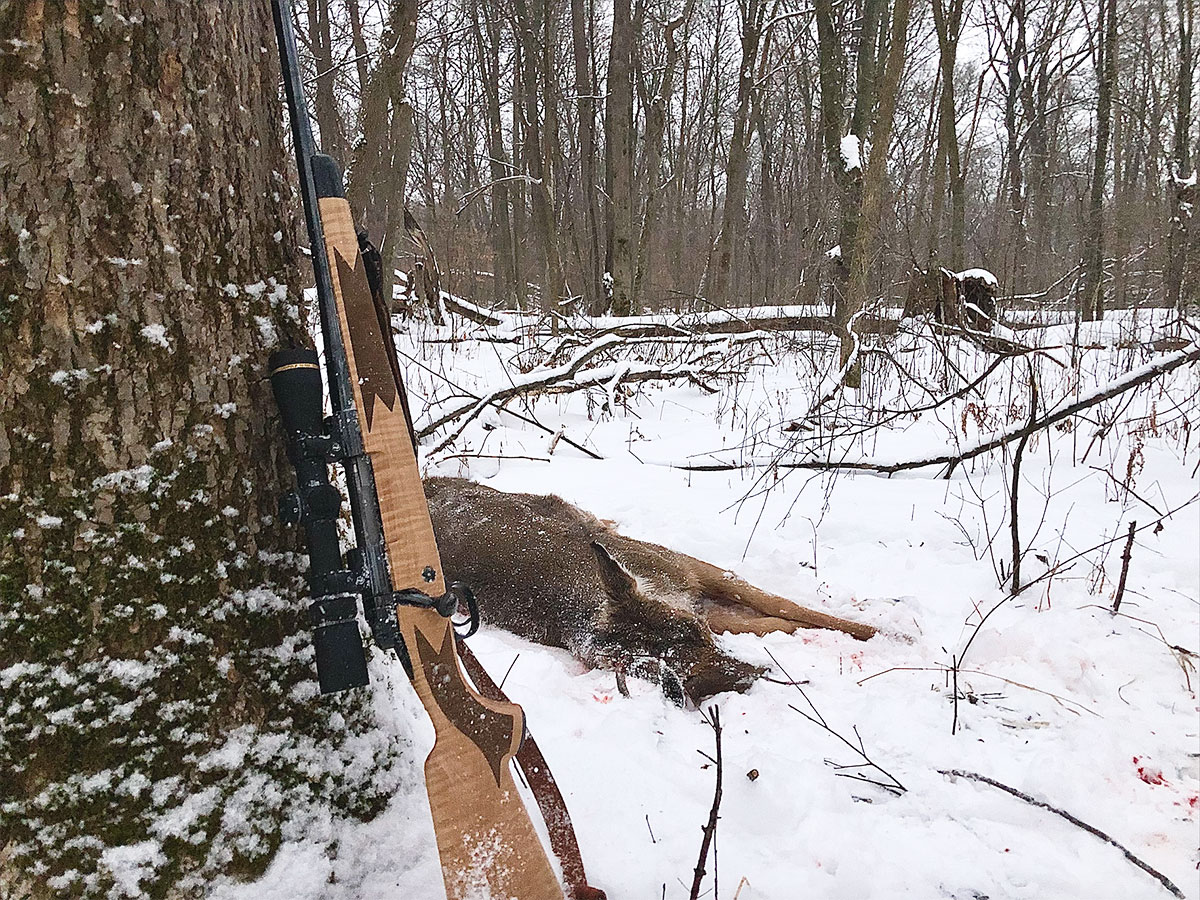
What does matter is that the rifle points and handles wonderfully. It comes to my shoulder quickly and naturally and is easy to shoot offhand. This has become my go-to whitetail deer hunting rifle, so handling is a priority. It weighs 8 pounds but does not feel that heavy in hand. The trigger is excellent for a deer rifle, at a crisp 2 pounds, 9 ounces. As for accuracy, with a variety of standard deer hunting loads my five-shot groups range from a little over an inch to 1.75 inches on the upper end. This is not excellent accuracy for a modern rifle, but it’s more than adequate for Northwoods deer hunting. Plus, for all the looks and features built into this rifle, it’s surprisingly affordable and makes a strong case for new wood-stocked deer hunting rifles. —A.R.
Savage Impulse
Key Features
- Caliber: 6.5 Creedmoor
- Weight: 8.8 pounds
- Stock: Synthetic, with adjustable length of pull and comb height
- Barrel: 22 in., fluted and threaded ⅝-24
- Trigger: 3 lb. 1 oz., user-adjustable AccuTrigger
Why It Made the Cut
This innovative American-made rifle is an affordable straight-pull bolt gun.
Pros
- Ambidextrous
- Accurate
- Affordable for the type
Cons
- A bit heavy
The Savage Impulse was one of the unexpected delights of 2021. I don’t think many people had “American-made straight-pull bolt-action” on their bingo cards, let alone one that wouldn’t break the bank.
To their credit, Savage got the platform correct out of the gate. Pulling off an all-new design is no easy feat, yet the Impulse functioned and performed extremely well.
I have one in 6.5 Creedmoor that I’ve hunted with and have shot extensively, and after several hundred rounds it is still humming along.
Mine is a solidly sub-MOA rifle, turning in good groups with several different types of ammo and I used it to good effect on a very nice Texas aoudad.
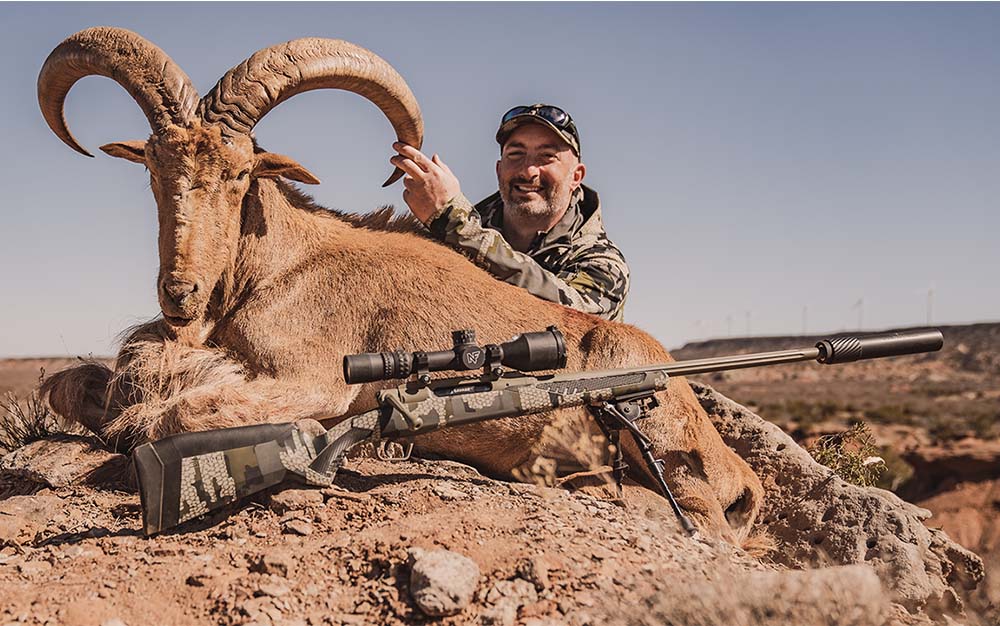
The Impulse is available in several different trims. Mine is the Big Game, decked out in KUIU’s Verde pattern. There’s also the Hog Hunter, which has a shorter barrel, the Predator, which comes with a 10-round detachable box magazine, and the Elite Precision, which was introduced this year, and is built on an MDT chassis stock.
If you’re a 6.5 Creedmoor hater, fret not. The Impulse is available in a variety cartridges, including .22/250 Rem., .243 Win., 6 Creedmoor, .308 Win., .30/06, .300 WSM, .300 Win. Mag., .300 PRC., and .338 Lapua. —J.B.S
Mossberg Patriot Predator
Key Features
- Caliber: 6.5 Creedmoor
- Weight: 6 lb. 8 oz.
- Stock: Synthetic
- Barrel: 22 in. threaded ⅝-24
- Trigger: User adjustable
Why It Made the Cut
The Mossberg Patriot Predator is one of the best values in a big-game hunting rifle.
Pros
- Affordable
- Tough
- Accurate
Cons
- Fit and finish in line with price point
I’ve hunted with Mossberg Patriots from Mexico to Alaska and plenty of points in between—mostly in the Predator configuration, which is my favorite among Mossberg’s offerings. It is a rugged, go-anywhere, hunt-anything rifle that delivers a lot of performance at an excellent price.
The initial Patriot Predators were available in 6.5 Creedmoor, .243 Win., and .308 Win. But since its introduction, the Predator line has expanded to include short-barrel thumpers in .450 Bushmaster, the stuff of prairie dog nightmares—the .22/250 Rem.—and the 6.5 PRC.
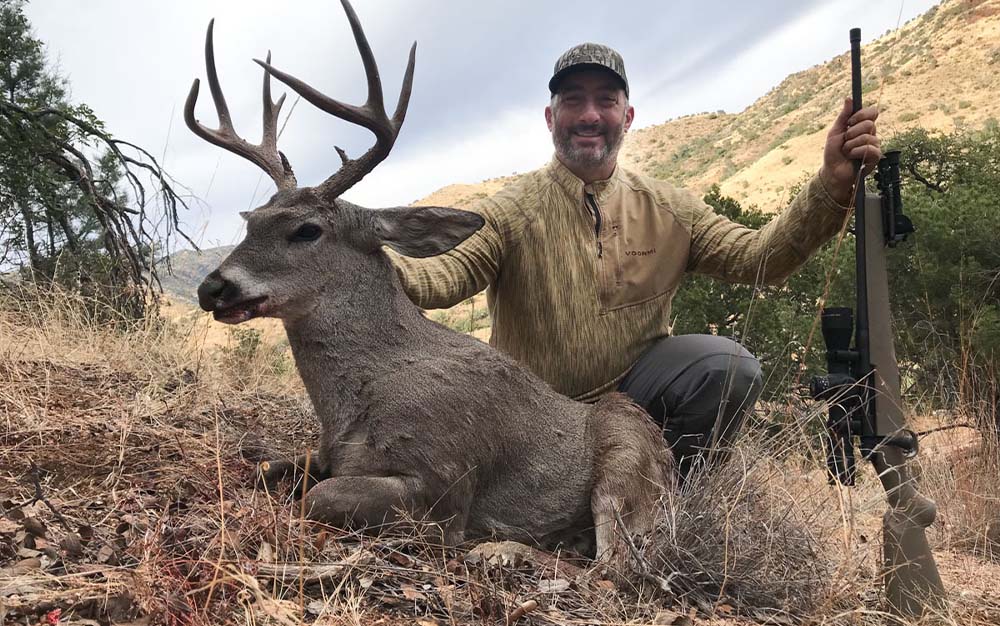
In terms of features, it has the basics you need and little else. The barrels are threaded for muzzle devices. The action comes topped with a Picatinny rail. And it uses a lightweight and easy-to-load detachable box magazine that helps the rifle feed flawlessly.
The two-lug action is pretty smooth, and the Predator’s slightly oversized bolt handle makes running the rifle that much easier.
In terms of aesthetic touches, the barrel has some fluting as does the bolt. But this rifle isn’t about winning beauty contests. Instead, it is a gun you wouldn’t mind hauling around in your truck while at the same time being a tool you can count on during a high-stakes big-game hunt. —J.B.S
Read more about the Mossberg Patriot Predator and see how it compares to other budget hunting rifles in our Best Budget Hunting Rifles test.
Allterra Arms Mountain Shadow Steel
Key Features
- Caliber: 6.5 PRC
- Weight: 6 lb. 12 oz.
- Stock: Carbon fiber
- Barrel: 22 in. sporter, threaded ⅝-24
- Trigger: 2 lb. 8 oz. TriggerTech Primary adjustable
Why It Made the Cut
This High-end rifle with custom features delivers high-end performance.
Pros
- Exceptional accuracy
- Great fit and finish
- Excellent customer service
Cons
- Expensive
Allterra Arms goal is to build the finest bolt-action rifle money can buy and to make sure that the rifle lives up to their high standards.
Lofty words, but the craftsmen at Allterra Arms have the skills to back it up. They make five different rifles currently, and each is customizable depending on the customer’s preference and budget.
I went with the Mountain Shadow Steel, which I took on a bighorn sheep hunt in Alberta last fall. Like all Allterra rifles it is based on their C2 action, which is milled to incorporate an integral recoil lug and makes extensive uses of EDM machining to precisely cut the receiver, which they say holds .0005 in. (half a thousandth of an inch) tolerance.
That level of persnickety engineering is maintained throughout all steps in the rifle’s build. As a result, Allterra has a 3-shot .5-inch guarantee with quality factory ammo.
My rifle, decked out in a very cool, and slightly trippy, swirling green, white, and gray pattern on its stock, hits that standard without any issues.
With its 22-inch barrel, the rifle is handy to wield and can accommodate a suppressor without becoming cumbersome to haul about. I got mine chambered in 6.5 PRC, but you can choose from a long list of cartridges should you want to add one of these premium rifles to your collection. —JBS
How to Choose the Best Hunting Rifle
There are great all-around hunting rifles, and there are highly-specialized niche rifles, but there are no one-size-fits-all hunting rifles. So to choose the best hunting rifle for you, you must consider several factors including caliber, weight, accuracy, aesthetics, fit, handling, and price. Then compare hwo those factors match with how, where, and what you hunt.
Caliber
Many hunters over-think cartridge selection. The truth is that most common medium-to-large calibers are completely adequate for most North American big game when paired with the right bullet. Caliber is still relevant however, and in-general, you want to pick a chambering that’s got adequate power for the distances and game you plan to shoot, but not so powerful that you can’t shoot it comfortably and consistently.
Weight
Hunting rifle weight might mean everything, or it might not mean much at all—it just depends on your situation. If you’re primarily backpack hunting in the mountains, you might want to look for a rifle that weighs less than 7 pounds without an optic. The farther you have to carry your rifle, the more important weight becomes. For an all-around hunting rifle, medium-to-heavy rifles (7 to 9 pounds) have advantages—namely that they are much easier to shoot accurately but they’re still not too heavy to carry through the hills. If you don’t have to carry your rifle far, a heavier rifle on a solid rest can be easier to shoot.
Accuracy
A lot of value is placed on rifle accuracy, and understandably so. It’s one of the key metrics we use to evaluate rifles. But it can be over emphasized as well. While it is comforting to have a rifle that consistently shoots ¾-inch 5-shot groups—and many of the rifles in this list will do just that—most hunting rifles don’t meet that threshold. What matters more is how a rifle performs under real-world conditions, and if you have a rifle that can put a 3-shot group on paper at 200 yards that measures 4-inches from a practical field position, you are good to go.
Accuracy becomes more critical when hunting wide open country, where longer shots are the norm. If your rifle is a 1.5 inch-gun from the bench, you can hunt with it out to 400 yards with complete confidence. Beyond 400 yards, it gets more complicated. Not only is rifle accuracy a paramount concern, but a host of other factors have an outsized influence on where your bullet strikes. Understanding the wind and the exact drop of your bullet, having consistent ammo, and employing good shooting fundamentals are all critical.
Aesthetics, Handling, and Fit
Some hunters don’t care how ugly their rifle is, as long as it functions flawlessly and shoots accurately. Other hunters place a lot of value on nice-looking rifles. Just make sure to pick one that looks good to you—it doesn’t matter what your buddy’s tastes are. More importantly, get one that fits you well. The rifle should come up to your shoulder naturally and function smoothly in your hands. Choose a rifle with a quality finish that will hold up to the weather conditions you’ll be dealing with. Ugly or gorgeous, you want a rifle that will last.
Price
Good guns have never been cheap, but everyone still wants the most bang for their buck. Many hunters find that budget-priced hunting rifles ($500 to $600) work just fine for them—and there are some gems out there. But if you have the money, spend it. With higher-end rifles you’re generally getting better quality, better aesthetics, more accuracy, and more features.
FAQs
Hunting rifles can cost anywhere from $500 to $8,000 or more. New hunters will want to focus on the lower end of that scale, but don’t go too cheap. There are a ton of great rifles in the $500 to $1000 price range. Our best value rifle of the year, the Stevens 334 Walnut, costs $489.
The most important quality in a hunting rifle is that it functions as intended in your hands and is built to withstand the rigors of your hunting style. This means that the action should run smoothly from your shoulder and all the controls, like the safety and magazine release, should be easy and intuitive to manipulate. The rifle should be easy to load and unload, whether it has an internal magazine or a detachable box magazine.
The trigger should have a crisp, consistent break that is no more than 3 pounds for a bolt gun and 6 pounds for a lever action. The stock and metalwork should have a durable finish that can withstand the elements.
Don’t get too hung up on accuracy. There’s a lot of talk about sub-MOA hunting rifles on the internet. Much of that is fueled by a desire to boast and exaggerate. In reality, most affordable hunting rifles with standard hunting ammunition will not average sub-MOA groups, especially in the hands of a newer hunter. If you’re able to print 2-inch groups with your hunting rifle and factory hunting ammo, you’re doing just fine. Work on improving your marksmanship before chasing accuracy with a credit card.
Final Thoughts
Searching around for the best hunting rifle is fun. It’s so fun, in fact, that you’ll probably want to do it many times over the course of your hunting career. So don’t worry too much about finding a rifle that does absolutely everything. Start with a gun that fits your needs now and know that there are other “best hunting rifles” waiting for you as you gain more hunting experience. There are too many great hunting rifles out there for you to own just one.
